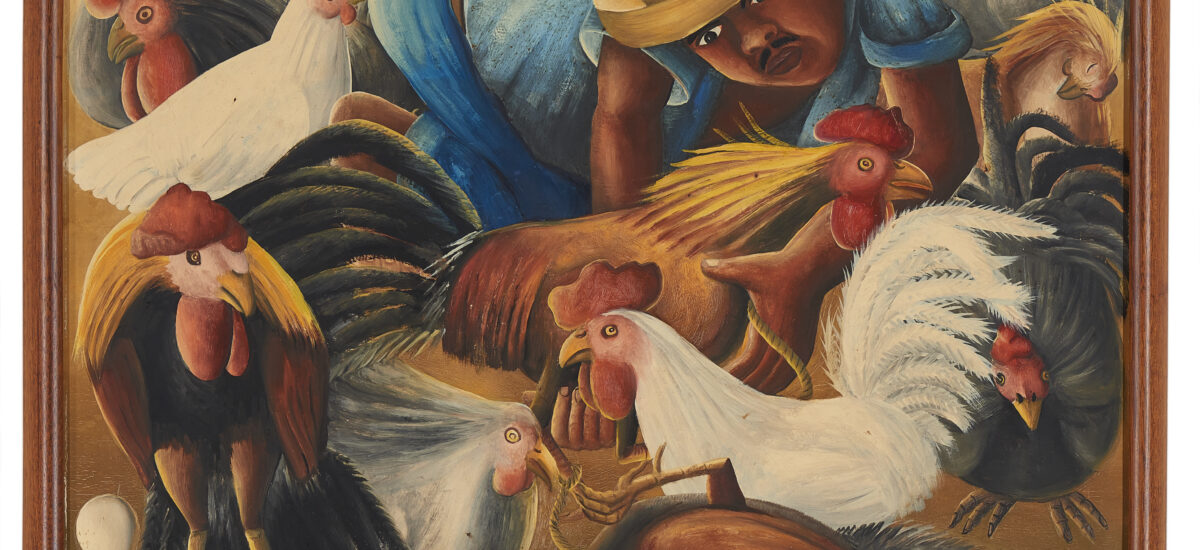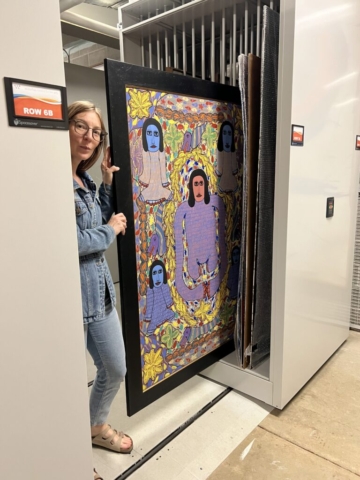Wilson Bigaud (b. 1905 – 2010) / Chicken Farmer, 1957 / Oil on board / WCA Collection
“Haitian painting challenges the magical notion of ‘authenticity’ in art. It is a community endeavor. An entire people’s discourse. The measure of its dynamism.”
- Glissant, Édouard, and J. Michael Dash (transl.). Caribbean Discourse : Selected Essays. University Press of Virginia, 1989. 157.
In the above quotation, Martinican philosopher Edouard Glissant’s proclamations on Haitian painting relate to the expansiveness of the medium and its practitioners. Painting in Haiti presents a “cross-cultural poetics,” one that incorporates symbolism and the marvelous to contribute to a broader pictorial discourse. In Glissant’s writing on cultural production, Haitian painting presents significations beyond provenance. Akin to oral traditions across the African diaspora, Haitian art presents a form of knowledge, providing a marker, sign and narrative relative to its historical context and contemporary society.
The expansiveness of Haiti’s pictorial discourse is evident at the Waterloo Center for the Arts (WCA), where paintings comprise the majority of the Haitian art collection. The medium of painting forms a robust tradition dating back to early 19th century. In the mid-twentieth century many artists became noted for the personal style, establishing influence and even schools of art. The quantity of paintings at the WCA is indicative of the broad appeal of the medium and its an expanded market and audiences. Information about paintings, however, remains inconsistent. In our process of digitization, an expanded metadata schema hopes to counter the current lack of information about specific paintings. We hope to connect artists and speak to the influences, with the hopes of contributing to an art history that can look at the development of Haitian art across generations.
In December 2019, an HADC team comprised of Fredo Rivera and three student researchers conducted a trip exploring public collections of Haitian art in South Florida.

During a visit to the NSU Art Museum Ft. Lauderdale we discussed their method for photographing and preserving works during the digitization process. One important note taken from Director Bonnie Clearwater and Exhibitions Registrar Diana Blanco is that the back of the canvas sometimes included important information, such as stamps or stickers identifying the work with galleries, schools of art or other entities. Some works came in original frames provided by the gallery or artist that sold the work, while others were just a stretched canvas or board, or even unstretched. The museum had done a careful job of photographing the back of the canvas, to record these variations.
HADC incorporates a similar process in our digitization of paintings in the WCA and other collections. Our metadata schema will provide a space for relaying information that may appear on the flip side of the painting. We seek to go beyond the surface of the canvas or board, helping build a provenance for Haitian painting and its genealogy.
Haitian paintings at the NSU Art Museum Fort Lauderdale’s storage facility in Davie. Note the stamps on the back of the canvas.



